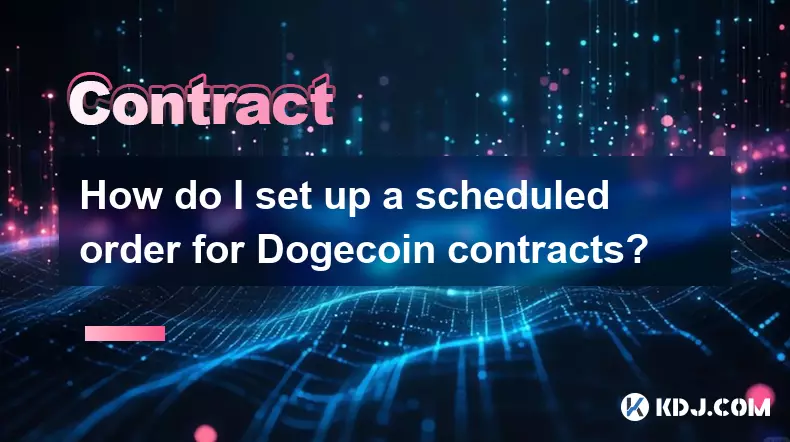-
 bitcoin
bitcoin $112195.049338 USD
2.42% -
 ethereum
ethereum $4124.915858 USD
2.81% -
 tether
tether $1.000570 USD
0.02% -
 xrp
xrp $2.861568 USD
2.25% -
 bnb
bnb $1000.346670 USD
3.04% -
 solana
solana $209.070819 USD
3.38% -
 usd-coin
usd-coin $0.999870 USD
0.02% -
 dogecoin
dogecoin $0.235379 USD
2.65% -
 tron
tron $0.335681 USD
-0.20% -
 cardano
cardano $0.803501 USD
3.38% -
 hyperliquid
hyperliquid $47.120881 USD
3.56% -
 chainlink
chainlink $21.501300 USD
3.44% -
 ethena-usde
ethena-usde $1.000571 USD
0.02% -
 avalanche
avalanche $29.793378 USD
3.62% -
 stellar
stellar $0.366964 USD
2.42%
How do I set up a scheduled order for Dogecoin contracts?
Scheduled Dogecoin contract orders automate trades at set times or conditions on platforms like Binance and Bybit, requiring sufficient margin and security measures like 2FA.
Sep 29, 2025 at 01:18 pm

Understanding Scheduled Orders in Dogecoin Contracts
1. A scheduled order in the context of Dogecoin contracts refers to a pre-configured trade instruction that executes at a specific time or under certain market conditions. These orders are particularly useful for traders who want to automate their strategy without constant monitoring. The functionality is supported on several advanced derivatives platforms that list DOGE perpetual or futures contracts.
2. Before setting up a scheduled order, ensure your chosen exchange supports contract trading for Dogecoin and offers automation tools such as conditional triggers or time-based execution. Platforms like Bybit, OKX, and Binance provide robust APIs and built-in scheduling features for futures markets.
3. Access to margin or isolated positions is required when placing contract orders. Verify that your account has sufficient collateral in the designated settlement currency—often USDT or USDⓈ—to cover potential margin requirements tied to your scheduled position.
4. Security settings such as two-factor authentication (2FA) must be active. Exchanges typically require additional verification layers before allowing automated trading actions to prevent unauthorized access and unintended executions.
Steps to Configure a Time-Based Contract Order
1. Log into your preferred cryptocurrency derivatives exchange and navigate to the Dogecoin futures or perpetual contract section. Select the specific pair, such as DOGE/USDT or DOGE/USD.
2. Switch to the “Advanced” or “Conditional” order mode. Look for options labeled “Scheduled Order,” “Planned Order,” or “Trigger Order.” Not all interfaces use identical terminology, but these modes allow delayed execution based on time or price thresholds.
3. Define the execution time using either UTC or local timestamp input. Some platforms let you set one-time or recurring schedules. Input the desired quantity, direction (long or short), and leverage level applicable at the time of execution.
4. Confirm the order parameters including take-profit and stop-loss levels if available within the scheduling tool. These risk controls help manage exposure even when trades are automatically initiated.
5. Submit the order and verify its presence in the “Open Orders” or “Scheduled” tab. Most systems send a confirmation alert via email or app notification once the order is registered in the system queue.
Using API Scripts for Automated Scheduling
1. For greater flexibility, traders often use REST or WebSocket APIs provided by exchanges to program custom timing logic. This method allows precise control over when a Dogecoin contract order is placed, modified, or canceled.
2. Generate API keys from your exchange profile with permissions limited to 'trade' and 'read' access—avoid enabling withdrawal rights for security reasons. Bind the key to an IP address if the platform supports it.
3. Write a script in Python or Node.js that sends a POST request to the exchange’s order endpoint at a predefined interval. Use cron jobs on Linux or Task Scheduler on Windows to trigger the script at exact times.
4. Incorporate error handling to manage rate limits, connection timeouts, or insufficient balance scenarios. Logging each attempt ensures traceability and aids in debugging failed executions.
Ensure the script validates current market data before submission to avoid stale pricing assumptions that could lead to unfavorable fills.Monitoring and Managing Active Scheduled Orders
1. Regularly check the status dashboard for any pending scheduled orders. Delays may occur due to server load, network latency, or temporary maintenance on the exchange side.
2. Adjust or cancel scheduled entries if market fundamentals shift unexpectedly. Events such as major Elon Musk tweets or macroeconomic announcements can drastically alter DOGE price dynamics before an automated trade activates.
3. Review historical execution reports after each scheduled event. Analyze slippage, fill rates, and timing accuracy to refine future setups. Consistent tracking improves long-term reliability of automated strategies.
4. Disable unused scheduled orders to prevent accidental activations during volatile periods. Keeping the order queue clean reduces operational risk and enhances focus on active positions.
Frequently Asked Questions
Can I schedule a limit order for Dogecoin futures on Binance?Yes, Binance allows users to place conditional limit orders for DOGEUSDT futures through the “Plan Order” feature. You can set both entry time and price conditions, along with associated TP/SL parameters.
What happens if my scheduled Dogecoin contract order fails to execute?Execution failure can result from insufficient margin, connectivity issues, or invalid parameters. The system usually logs the reason in the notification center or API response. Re-evaluate the order settings and resubmit if necessary.
Is it possible to modify a scheduled order after creation?Most platforms permit editing or cancellation of scheduled orders before they trigger. Once the activation criteria are met, changes are no longer allowed. Always double-check details prior to submission.
Do scheduled orders work during weekends or holidays?Yes, scheduled orders operate continuously regardless of day or time, assuming the exchange’s matching engine is live. Dogecoin futures markets generally run 24/7, so time-based triggers will activate as programmed.
Disclaimer:info@kdj.com
The information provided is not trading advice. kdj.com does not assume any responsibility for any investments made based on the information provided in this article. Cryptocurrencies are highly volatile and it is highly recommended that you invest with caution after thorough research!
If you believe that the content used on this website infringes your copyright, please contact us immediately (info@kdj.com) and we will delete it promptly.
- Navigating Misinformation: Ensuring Safety in the Pi Network Ecosystem
- 2025-09-29 14:25:13
- XRP Price Prediction: September 29th's Crypto Comeback?
- 2025-09-29 14:25:13
- Polkadot vs. Lyno AI: Decoding the Price Forecast and AI Revolution
- 2025-09-29 14:30:01
- Trump's Brahmastra: Can Stable Coin Save the US Economy?
- 2025-09-29 14:45:17
- Pi Movement: Utility, Community, and the $314,159 Dream
- 2025-09-29 14:45:17
- Ruvi AI: Revolutionizing the Creator Economy with AI-Powered Crypto
- 2025-09-29 14:30:01
Related knowledge

How do I use the scheduled order feature in Cardano (ADA) contracts?
Sep 28,2025 at 10:18pm
Understanding Scheduled Orders in Cardano Smart ContractsCardano operates on a proof-of-stakes consensus mechanism and uses the Plutus scripting langu...

How do I enable the "scalping-only" mode for Cardano (ADA) contracts?
Sep 24,2025 at 03:19am
Understanding Scalping Strategies in Crypto Derivatives1. Scalping in cryptocurrency trading refers to executing multiple short-term trades within min...

What is the settlement time for Cardano (ADA) contracts?
Sep 28,2025 at 04:18am
Understanding Cardano's Contract Settlement Mechanism1. Cardano operates on a proof-of-stake consensus model known as Ouroboros, which fundamentally i...

How do I add margin to Cardano (ADA) contracts?
Sep 27,2025 at 07:54pm
Understanding Margin in Cardano (ADA) Smart ContractsCardano operates on a proof-of-stake blockchain that supports smart contracts through its Plutus ...

What is the maximum position limit for Cardano (ADA) contracts?
Sep 23,2025 at 11:00pm
Understanding ADA Futures and Derivatives Market Structure1. Cardano (ADA) futures contracts are offered by several major cryptocurrency derivatives e...

What is the maker fee for Cardano (ADA) contracts?
Sep 26,2025 at 09:01am
Understanding Maker Fees in Cardano (ADA) Contracts1. The concept of maker fees applies broadly across decentralized exchanges and smart contract plat...

How do I use the scheduled order feature in Cardano (ADA) contracts?
Sep 28,2025 at 10:18pm
Understanding Scheduled Orders in Cardano Smart ContractsCardano operates on a proof-of-stakes consensus mechanism and uses the Plutus scripting langu...

How do I enable the "scalping-only" mode for Cardano (ADA) contracts?
Sep 24,2025 at 03:19am
Understanding Scalping Strategies in Crypto Derivatives1. Scalping in cryptocurrency trading refers to executing multiple short-term trades within min...

What is the settlement time for Cardano (ADA) contracts?
Sep 28,2025 at 04:18am
Understanding Cardano's Contract Settlement Mechanism1. Cardano operates on a proof-of-stake consensus model known as Ouroboros, which fundamentally i...

How do I add margin to Cardano (ADA) contracts?
Sep 27,2025 at 07:54pm
Understanding Margin in Cardano (ADA) Smart ContractsCardano operates on a proof-of-stake blockchain that supports smart contracts through its Plutus ...

What is the maximum position limit for Cardano (ADA) contracts?
Sep 23,2025 at 11:00pm
Understanding ADA Futures and Derivatives Market Structure1. Cardano (ADA) futures contracts are offered by several major cryptocurrency derivatives e...

What is the maker fee for Cardano (ADA) contracts?
Sep 26,2025 at 09:01am
Understanding Maker Fees in Cardano (ADA) Contracts1. The concept of maker fees applies broadly across decentralized exchanges and smart contract plat...
See all articles










































































